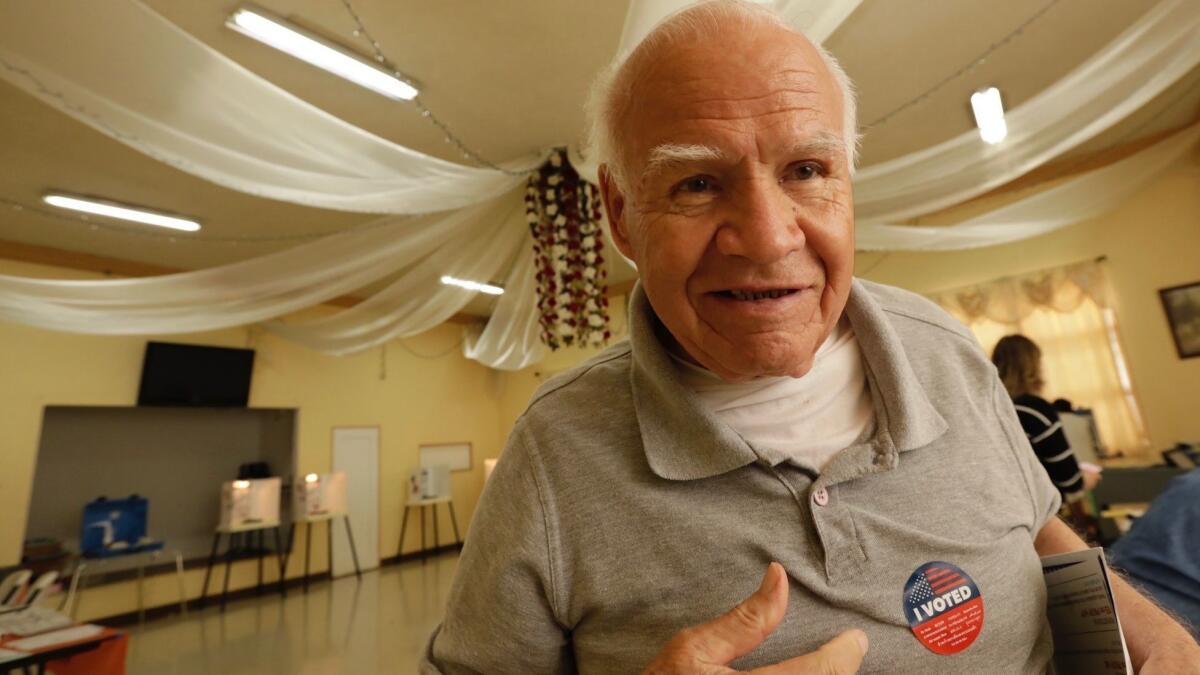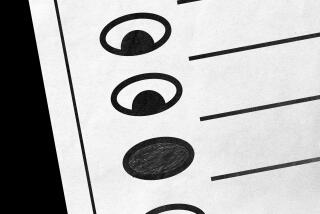Capitol Journal: Give California’s top-two primary some more time, and if it doesn’t get better, junk it

Reporting from Sacramento — Like evolving insects, politicians have adapted and learned how to strategically use California’s top-two open primary system to help them survive.
But voters have not adapted and don’t seem interested in doing so. They’re essentially ignoring the substantial election changes they approved eight years ago and behaving as if we were still back in the era of closed party primaries.
The problem is that California now has a nonpartisan election system for selecting partisan politicians for partisan office. And three-fourths of the voters are registered as party partisans. Trying to blend a nonpartisan election process with partisan politics is like mixing oil and water.
So, many in the world of politics and academia think we should scrap the new system and return to the old.
One major reason cited by critics who want to abandon top-two is that the actions of some clever politicians in last week’s primary were the unintended consequences of “reform.”
In California’s open primary, the top two finishers advance to the November general election regardless of their party. All candidates appear on the same ballot and voters can choose one of any party. No longer are there party nominations.
The electorate is still voting tribally — Republicans for Republicans, Democrats for Democrats — especially in this polarized era of hyperpartisanship.
The nonpartisan primary “is a crazy thing for voters,” says Eric McGhee, a political reform analyst at the Public Policy Institute of California. “They use party identification as a shortcut for making decisions on candidates. The top-two doesn’t change that. It just lets them vote across party lines if they want to. Most don’t.”
“That’s what creates potential for weird outcomes that are problematic.”
In last week’s primary, some campaigns gamed the system to promote their perceived weakest general election opponent. It’s all perfectly legal, even if a tad odorous.
The classic was Lt. Gov. Gavin Newsom covertly helping Republican businessman John Cox advance to the November runoff. Newsom, who admitted he would rather face a Republican than a fellow Democrat, ran a TV ad ostensibly attacking Cox for “standing with Donald Trump and the NRA.” That made the little-known Cox a hero among Republican voters.
A more outrageous incident occurred in the race to replace retiring U.S. Rep. Darrell Issa (R-Vista). That’s a Republican seat Democrats are trying to flip in an effort to recapture the House.
One Republican candidate, State Assemblyman Rocky Chavez of Oceanside, was considered a dangerous threat by Democratic honchos in Washington. Chavez is a former Marine colonel, oozes integrity and is a rare Republican moderate — just the type who could win in that competitive district.
The vulnerability for Chavez is that he sided with Gov. Jerry Brown and Democratic legislators by casting a crucial vote to extend the governor’s climate change program known as cap-and-trade. He also voted for the state budget. So jackals at the Democratic Congressional Campaign Committee leaped.
The Democrats spent $1.6 million tearing Chavez apart, equating a vote for cap-and-trade with raising taxes. “Rocky Chavez promised he’d never raise taxes and would oppose wasteful spending,” the Democratic-funded ad regurgitated. “Then Rocky did the opposite.”
Chavez lost support among GOP voters and finished sixth behind two other Republicans.
Any Sacramento Republican would be nuts to vote with Democrats on a controversial issue again any time soon.
Shady game-playing was not what open primary reformers intended. Their intent was to provide voters a wider ideological choice of candidates with the goal of electing more moderates. Whether more centrists are being elected is debatable.
Coverage of California politics »
“It has been incredibly effective,” insists Democratic consultant David Townsend, who co-managed the top-two ballot measure in 2010. “We’ve gone from six [Assembly] moderates 14 years ago to 22 today.”
Paul Mitchell, who runs the political research firm Political Data Inc., disagrees: “A more moderate Legislature? It just isn’t true.”
Political researcher McGhee says, “The Democratic caucus is a little bit more moderate, but it hasn’t resulted in much change.” Anyway, he adds, most of the minimal moderation is due to two other reforms: nonpartisan redrawing of legislative districts and an easing of term limits.
The only significant moderation I’ve seen in Sacramento is in the governor’s office. Brown has been a fiscal moderate, but that seems about to change with the probable election of Newsom, the former San Francisco mayor.
There’s also a complaint that the top-two primary can produce one-party general election contests. That means either no Democrat or no Republican candidate. And no room for third party or write-in candidates.
Some changes I’d suggest:
—Make it tougher to qualify for the ballot by requiring far more voter signatures. Also significantly raise the filing fee. We don’t need 27 gubernatorial candidates cluttering the ballot, the vast majority not serious and not campaigning.
—If a candidate for partisan office draws more than 50% of the primary vote, that contender is elected. No second race in November is necessary. That’s the way it works for nonpartisan offices, such as mayor.
—Allow write-in candidates in November.
But should the top-two primary be junked?
“It’s not perfect, but it’s better than what we had,” says Democratic strategist Garry South, a longtime open primary supporter.
“It’s time to repeal the wacky system,” Democratic consultant Katie Merrill says. “It has not achieved its goal of getting more moderates in office.”
Fact is, it would be very difficult to talk voters into abolishing the system. Voters think they like it.
Now’s not a good time to try. Give it another election cycle or two. Then, if voters still aren’t using it and candidates are misusing it, dump the thing.
Follow @LATimesSkelton on Twitter
More to Read
Get the L.A. Times Politics newsletter
Deeply reported insights into legislation, politics and policy from Sacramento, Washington and beyond. In your inbox three times per week.
You may occasionally receive promotional content from the Los Angeles Times.











